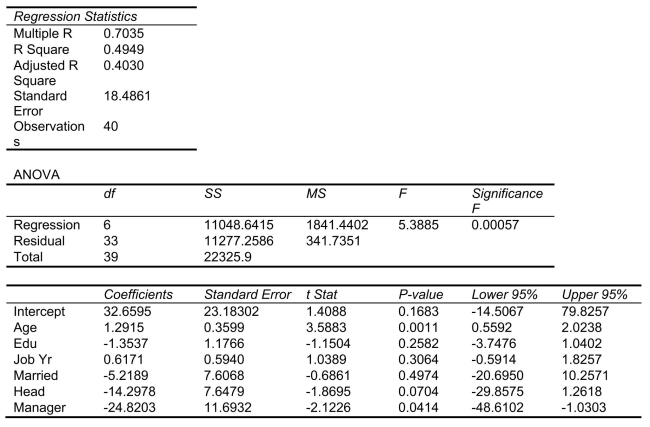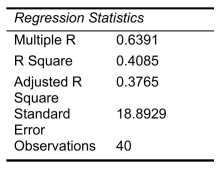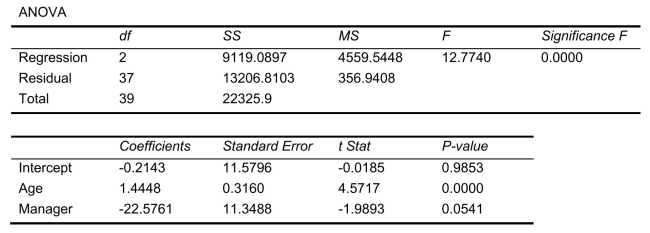SCENARIO 18-10 Given below are results from the regression analysis where the dependent variable is the number of weeks a worker is unemployed due to a layoff (Unemploy)and the independent variables are the age of the worker (Age), the number of years of education received (Edu), the number of years at the previous job (Job Yr), a dummy variable for marital status (Married: 1 = married, 0 = otherwise), a dummy variable for head of household (Head: 1 = yes, 0 = no)and a dummy variable for management position (Manager: 1 = yes, 0 = no).We shall call this Model 1.The coefficient of partial determination  of each of the 6 predictors are, respectively, 0.2807, 0.0386, 0.0317, 0.0141, 0.0958, and 0.1201.
of each of the 6 predictors are, respectively, 0.2807, 0.0386, 0.0317, 0.0141, 0.0958, and 0.1201.  Model 2 is the regression analysis where the dependent variable is Unemploy and the independent variables are Age and Manager.The results of the regression analysis are given below:
Model 2 is the regression analysis where the dependent variable is Unemploy and the independent variables are Age and Manager.The results of the regression analysis are given below: 

-Referring to Scenario 18-10 Model 1, we can conclude that, holding constant the effect of the other independent variables, there is a difference in the mean number of weeks a worker is unemployed due to a layoff between a worker who is married and one who is not at a 1% level of significance if all we have is the information of the 95% confidence interval estimate for 
Definitions:
High-Density Lipoprotein Cholesterol
A type of cholesterol in the blood, often referred to as "good" cholesterol, that helps to remove other forms of cholesterol from your bloodstream.
Total Cholesterol
The combined amount of all types of cholesterol in the blood, an important measure for assessing heart disease risk.
Harvard Alumni
Former students who have graduated or completed a course of study at Harvard University, often forming a professional and social network.
Heart Attack Risk
The likelihood of an individual experiencing a heart attack, influenced by factors such as genetics, lifestyle, and environmental conditions.
Q43: Referring to Scenario 16-13, what is your
Q47: Referring to Scenario 16-9, if one decides
Q103: Referring to Scenario 19-7, what is the
Q105: Referring to Scenario 16-13, what is the
Q111: Complete linkage can be used to measure
Q134: Referring to Scenario 18-10 Model 1, the
Q137: Referring to Scenario 16-13, what is your
Q137: Referring to Scenario 19-3, suppose the analyst
Q171: Referring to Scenario 18-10 Model 1, what
Q303: Referring to Scenario 18-4, if variables that